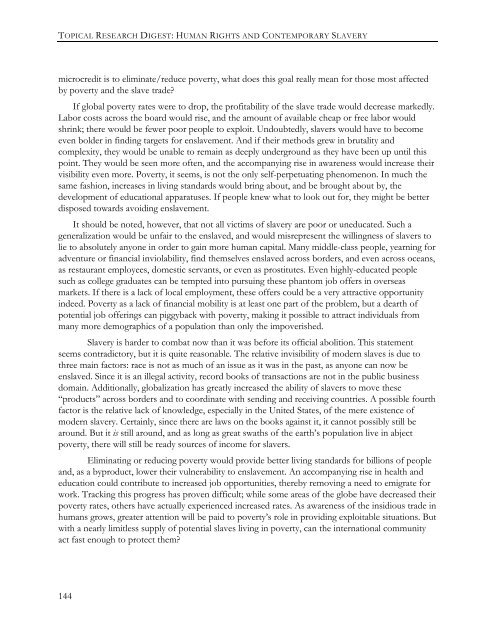Slavery in The 21st Century
Slavery in The 21st Century
Slavery in The 21st Century
You also want an ePaper? Increase the reach of your titles
YUMPU automatically turns print PDFs into web optimized ePapers that Google loves.
TOPICAL RESEARCH DIGEST: HUMAN RIGHTS AND CONTEMPORARY SLAVERY<br />
microcredit is to elim<strong>in</strong>ate/reduce poverty, what does this goal really mean for those most affected<br />
by poverty and the slave trade?<br />
If global poverty rates were to drop, the profitability of the slave trade would decrease markedly.<br />
Labor costs across the board would rise, and the amount of available cheap or free labor would<br />
shr<strong>in</strong>k; there would be fewer poor people to exploit. Undoubtedly, slavers would have to become<br />
even bolder <strong>in</strong> f<strong>in</strong>d<strong>in</strong>g targets for enslavement. And if their methods grew <strong>in</strong> brutality and<br />
complexity, they would be unable to rema<strong>in</strong> as deeply underground as they have been up until this<br />
po<strong>in</strong>t. <strong>The</strong>y would be seen more often, and the accompany<strong>in</strong>g rise <strong>in</strong> awareness would <strong>in</strong>crease their<br />
visibility even more. Poverty, it seems, is not the only self-perpetuat<strong>in</strong>g phenomenon. In much the<br />
same fashion, <strong>in</strong>creases <strong>in</strong> liv<strong>in</strong>g standards would br<strong>in</strong>g about, and be brought about by, the<br />
development of educational apparatuses. If people knew what to look out for, they might be better<br />
disposed towards avoid<strong>in</strong>g enslavement.<br />
It should be noted, however, that not all victims of slavery are poor or uneducated. Such a<br />
generalization would be unfair to the enslaved, and would misrepresent the will<strong>in</strong>gness of slavers to<br />
lie to absolutely anyone <strong>in</strong> order to ga<strong>in</strong> more human capital. Many middle-class people, yearn<strong>in</strong>g for<br />
adventure or f<strong>in</strong>ancial <strong>in</strong>violability, f<strong>in</strong>d themselves enslaved across borders, and even across oceans,<br />
as restaurant employees, domestic servants, or even as prostitutes. Even highly-educated people<br />
such as college graduates can be tempted <strong>in</strong>to pursu<strong>in</strong>g these phantom job offers <strong>in</strong> overseas<br />
markets. If there is a lack of local employment, these offers could be a very attractive opportunity<br />
<strong>in</strong>deed. Poverty as a lack of f<strong>in</strong>ancial mobility is at least one part of the problem, but a dearth of<br />
potential job offer<strong>in</strong>gs can piggyback with poverty, mak<strong>in</strong>g it possible to attract <strong>in</strong>dividuals from<br />
many more demographics of a population than only the impoverished.<br />
<strong>Slavery</strong> is harder to combat now than it was before its official abolition. This statement<br />
seems contradictory, but it is quite reasonable. <strong>The</strong> relative <strong>in</strong>visibility of modern slaves is due to<br />
three ma<strong>in</strong> factors: race is not as much of an issue as it was <strong>in</strong> the past, as anyone can now be<br />
enslaved. S<strong>in</strong>ce it is an illegal activity, record books of transactions are not <strong>in</strong> the public bus<strong>in</strong>ess<br />
doma<strong>in</strong>. Additionally, globalization has greatly <strong>in</strong>creased the ability of slavers to move these<br />
“products” across borders and to coord<strong>in</strong>ate with send<strong>in</strong>g and receiv<strong>in</strong>g countries. A possible fourth<br />
factor is the relative lack of knowledge, especially <strong>in</strong> the United States, of the mere existence of<br />
modern slavery. Certa<strong>in</strong>ly, s<strong>in</strong>ce there are laws on the books aga<strong>in</strong>st it, it cannot possibly still be<br />
around. But it is still around, and as long as great swaths of the earth’s population live <strong>in</strong> abject<br />
poverty, there will still be ready sources of <strong>in</strong>come for slavers.<br />
Elim<strong>in</strong>at<strong>in</strong>g or reduc<strong>in</strong>g poverty would provide better liv<strong>in</strong>g standards for billions of people<br />
and, as a byproduct, lower their vulnerability to enslavement. An accompany<strong>in</strong>g rise <strong>in</strong> health and<br />
education could contribute to <strong>in</strong>creased job opportunities, thereby remov<strong>in</strong>g a need to emigrate for<br />
work. Track<strong>in</strong>g this progress has proven difficult; while some areas of the globe have decreased their<br />
poverty rates, others have actually experienced <strong>in</strong>creased rates. As awareness of the <strong>in</strong>sidious trade <strong>in</strong><br />
humans grows, greater attention will be paid to poverty’s role <strong>in</strong> provid<strong>in</strong>g exploitable situations. But<br />
with a nearly limitless supply of potential slaves liv<strong>in</strong>g <strong>in</strong> poverty, can the <strong>in</strong>ternational community<br />
act fast enough to protect them?<br />
144

















